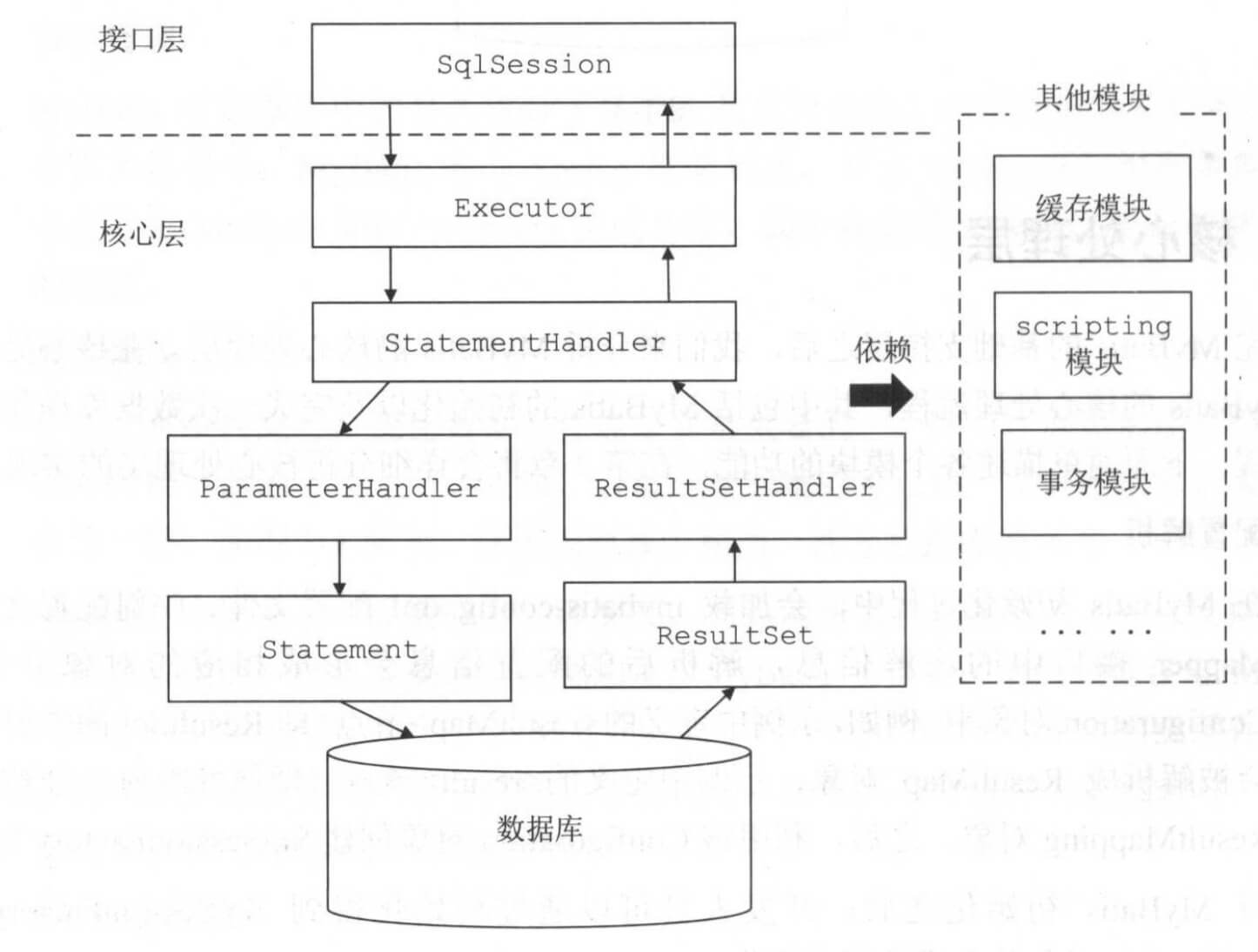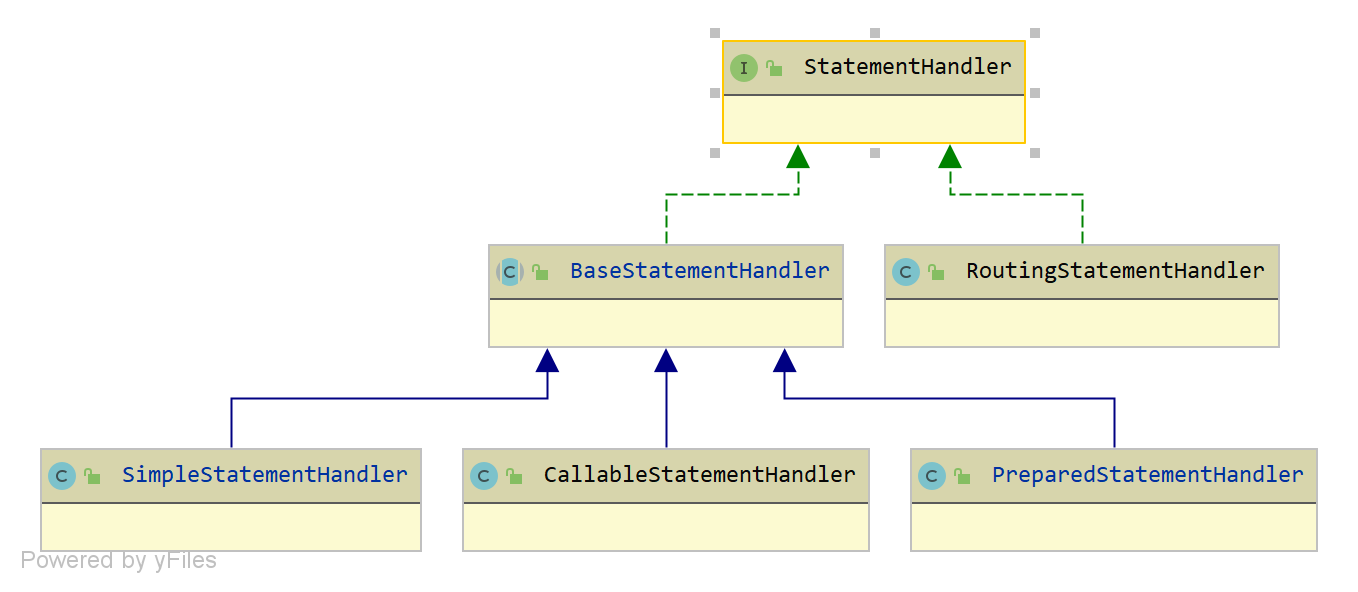精盡MyBatis原始碼分析 - SQL執行過程(二)之 StatementHandler
阿新 • • 發佈:2020-11-25
> 該系列文件是本人在學習 Mybatis 的原始碼過程中總結下來的,可能對讀者不太友好,請結合我的原始碼註釋([Mybatis原始碼分析 GitHub 地址](https://github.com/liu844869663/mybatis-3)、[Mybatis-Spring 原始碼分析 GitHub 地址](https://github.com/liu844869663/spring)、[Spring-Boot-Starter 原始碼分析 GitHub 地址](https://github.com/liu844869663/spring-boot-starter))進行閱讀
>
> MyBatis 版本:3.5.2
>
> MyBatis-Spring 版本:2.0.3
>
> MyBatis-Spring-Boot-Starter 版本:2.1.4
## MyBatis的SQL執行過程
在前面一系列的文件中,我已經分析了 MyBatis 的基礎支援層以及整個的初始化過程,此時 MyBatis 已經處於就緒狀態了,等待使用者發號施令了
那麼接下來我們來看看它執行SQL的整個過程,該過程比較複雜,涉及到二級快取,將返回結果轉換成 Java 物件以及延遲載入等等處理過程,這裡將一步一步地進行分析:
- [**《SQL執行過程(一)之Executor》**](https://www.cnblogs.com/lifullmoon/p/14015111.html)
- [**《SQL執行過程(二)之StatementHandler》**](https://www.cnblogs.com/lifullmoon/p/14015149.html)
- **《SQL執行過程(三)之ResultSetHandler》**
- **《SQL執行過程(四)之延遲載入》**
MyBatis中SQL執行的整體過程如下圖所示:


泛型
* @return 讀取的結果
*/
List query(Statement statement, ResultHandler resultHandler) throws SQLException;
/**
* 執行讀操作,返回 Cursor 物件
*
* @param statement Statement 物件
* @param 泛型
* @return Cursor 物件
*/
Cursor queryCursor(Statement statement) throws SQLException;
/**
* @return BoundSql 物件
*/
BoundSql getBoundSql();
/**
* @return ParameterHandler 物件
*/
ParameterHandler getParameterHandler();
}
```
每個方法可以根據註釋先理解它的作用,在實現類中的會講到
### RoutingStatementHandler
`org.apache.ibatis.executor.statement.RoutingStatementHandler`:實現StatementHandler介面,採用裝飾器模式,在初始化的時候根據Statement型別,建立對應的StatementHandler物件,程式碼如下:
```java
public class RoutingStatementHandler implements StatementHandler {
private final StatementHandler delegate;
public RoutingStatementHandler(Executor executor, MappedStatement ms, Object parameter, RowBounds rowBounds,
ResultHandler resultHandler, BoundSql boundSql) {
// 根據不同的型別,建立對應的 StatementHandler 實現類
switch (ms.getStatementType()) {
case STATEMENT:
delegate = new SimpleStatementHandler(executor, ms, parameter, rowBounds, resultHandler, boundSql);
break;
case PREPARED:
delegate = new PreparedStatementHandler(executor, ms, parameter, rowBounds, resultHandler, boundSql);
break;
case CALLABLE:
delegate = new CallableStatementHandler(executor, ms, parameter, rowBounds, resultHandler, boundSql);
break;
default:
throw new ExecutorException("Unknown statement type: " + ms.getStatementType());
}
}
}
```
- 在建構函式中初始化`delegate`委託物件,根據`MappedStatement`(每個SQL對應的物件)的`statementType`型別,建立對應的StatementHandler實現類
- 其餘所有的方法都是直接交由`delegate`去執行的,這裡就不列出來了,就是實現StatementHandler介面的方法
回顧到[**《MyBatis初始化(二)之載入Mapper介面與XML對映檔案》**](https://www.cnblogs.com/lifullmoon/p/14015046.html)中的**XMLStatementBuilder**小節,在`parseStatementNode`方法中的第`10`步如下:
```java
StatementType statementType = StatementType.valueOf(context.getStringAttribute("statementType", StatementType.PREPARED.toString()));
```
所以說`statementType`的預設值為`PREPARED`,委託物件也就是`PreparedStatementHandler`型別
### BaseStatementHandler
`org.apache.ibatis.executor.statement.BaseStatementHandler`:實現StatementHandler介面,提供骨架方法,指定的幾個抽象方法交由不同的子類去實現
#### 構造方法
```java
public abstract class BaseStatementHandler implements StatementHandler {
/**
* 全域性配置
*/
protected final Configuration configuration;
/**
* 例項工廠
*/
protected final ObjectFactory objectFactory;
/**
* 型別處理器登錄檔
*/
protected final TypeHandlerRegistry typeHandlerRegistry;
/**
* 執行結果處理器
*/
protected final ResultSetHandler resultSetHandler;
/**
* 引數處理器,預設 DefaultParameterHandler
*/
protected final ParameterHandler parameterHandler;
/**
* 執行器
*/
protected final Executor executor;
/**
* SQL 相關資訊
*/
protected final MappedStatement mappedStatement;
/**
* 分頁條件
*/
protected final RowBounds rowBounds;
/**
* SQL 語句
*/
protected BoundSql boundSql;
protected BaseStatementHandler(Executor executor, MappedStatement mappedStatement, Object parameterObject,
RowBounds rowBounds, ResultHandler resultHandler, BoundSql boundSql) {
this.configuration = mappedStatement.getConfiguration();
this.executor = executor;
this.mappedStatement = mappedStatement;
this.rowBounds = rowBounds;
this.typeHandlerRegistry = configuration.getTypeHandlerRegistry();
this.objectFactory = configuration.getObjectFactory();
// <1> 如果 boundSql 為空,更新資料庫的操作這裡傳入的物件會為 null
if (boundSql == null) { // issue #435, get the key before calculating the statement
// <1.1> 生成 key,定義了


